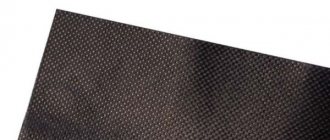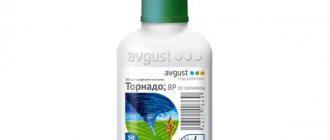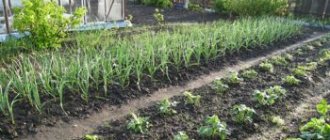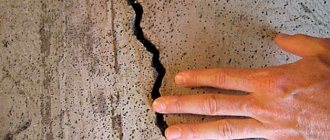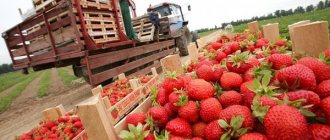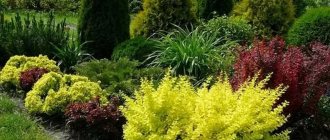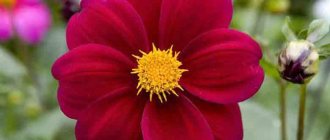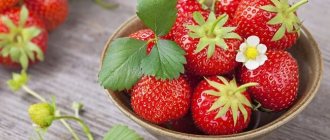1
(1)
Anyone who has encountered growing strawberries and other berry crops is familiar with the situation: you need to constantly pull out weeds, loosen the soil, and also prevent it from drying out. These actions take up a lot of precious time and effort. Of course, you can’t stop watering, but how can you reduce all this to a minimum? Someone solves such problems by mulching strawberries with straw or other materials. But a scientific solution to this issue is also available to the consumer of the 21st century. This is agrofibre (also called agrotextile), a type of spunbond. Covering with this material creates favorable conditions for the growth and fruiting of strawberries. Spunbond is cheaper than agrofibre, but its service life will be significantly shorter. In the article we will look at how to choose agrofibre for strawberries, how to care and water them after planting.
General characteristics of agrofibre
Agrofibre, unlike plastic film, will allow you to freely water strawberry plants and apply fertilizer without removing the covering. This material differs from the well-known film:
- quite light and dense;
- does not fade in the sun;
- inhibits moisture evaporation;
- protects against frost, pests and weeds.
What a close-up of strawberries planted on agrofibre looks like.
Also, a big advantage over other types of coverings is its compactness (easy to fold and remove from the garden) and the ability to use for more than 2 seasons. Sold in rolls (width from 1.5 to 4.2 m) in black and white, has a density range of 17-60 g/m² (the most important performance characteristic). The higher the density of the canvas, the less light it transmits.
Agrofibre weighing 17 g/m² transmits 80% of light, and dense 60 g/m² – up to 67%. For mulch, a material from 50 g/m² is suitable (nowadays a density of 80 g/m² has appeared on the market, but this is a different material - agrofabric). The presence of 4-5% ultraviolet stabilizer guarantees the durability of the agrofibre, and the uniform thickness of the fabric ensures the same temperature in the ground-shelter space.
White agrofibre protects against frost (from -2 to -8°C) and wind; black is intended to mulch the soil, protect against weeds, and inhibit the spread of diseases. By the way, black is produced exclusively in 50th density. It is possible to use white and black agrofibres simultaneously (you will get rid of weeds and create a positive microclimate not only in the soil, but also on the surface of the site). On sale you will find products from both domestic and foreign manufacturers. Farmers know about the existence of such brands as Agril, Agrotex, AgroSUF, Lutrasil, Agrospan, Spunbond. Depending on the density, the price for this covering material ranges from 10 to 50 rubles per 1 linear meter.
What is agrofibre
The use of film coatings when growing crops has been practiced for a long time. However, this material, with all its advantages, still does not fully meet all the requirements.
Widespread films do not allow moisture and air to pass through, so their scope of application is quite limited - creating a greenhouse effect in greenhouses or directly on beds.
To be fair, it can be noted that currently it is possible to purchase membrane films, in which this drawback is to some extent eliminated, but the cost of such materials is quite high, and not everyone can afford them.
The introduction of nonwoven materials into agricultural technology literally revolutionized agriculture.
Agrofibre is a lightweight covering fabric made from polypropylene fiber. This polymer is absolutely neutral and does not release any toxic substances into the soil or air.
All manufacturers of this non-woven material are required to obtain hygienic certification confirming its absolute safety for people, animals and plants.
The main advantages of this material are that its porous structure allows the passage of moisture, air and a certain range of sunlight. Thus, a unique microclimate is created in the beds or in greenhouses, the most favorable for the growth and development of plants.
The foliage can be protected from the glare of ultraviolet rays at the right time. During spring or autumn frosts, plants receive excellent protection from freezing.
In addition, agrofibre coverings protect crops from heavy rains, hail, and pest invasion.
Black agrofibre, which is absolutely non-transmitting to light, is especially used. This is a unique mulching covering of beds that completely prevents the growth of weeds and, at the same time, creates the most optimal temperature and humidity conditions on the soil surface, protecting it from drying out during the hot period.
Agrofibre is affordable and is significantly superior to film materials in all respects. Many farmers and owners of country plots have already appreciated its qualities.
Read about wine grape varieties on our website.
Find out the famous varieties of table grapes: https://rusfermer.net/sad/vinogradnik/sorta-vinograda/stolovye-sorta-vinograda.html
Features of agricultural technology when covering with black agrofibre
Volume of the harvest when growing a plant on agrofibre
If sow thistle shoots are even occasionally observed in the strawberry bed , and it belongs to the root shoot weeds , it must be removed. It is advisable to spray with a special herbicide. Why? Remaining under the spunbond, it will begin to grow and lift the canvas upward, and pulling out the sow thistle from under the cover is not so easy!
Remember, a lot of heat accumulates under black agrofibre, which is why in hot weather there is a risk of strawberries overheating. Therefore, after the sun, at sunset, you must water it.
How to plant strawberries on agrotextiles
Strawberries are a demanding crop and growing them will require a lot of effort. Drying or rotting of the soil, fertilizing, weed and pest control, difficulty in harvesting - such problems are well known to gardeners. Trying to solve these problems, people use a variety of means and methods, build pyramid beds, treat plants with chemicals, and pour sawdust under bushes. With the advent of agrofibre on sale, most of the above problems are a thing of the past!
Shelter with black and white agrotextiles
This textile appeared recently. This is the best choice. It is superior in functionality to ordinary black agrofibre. It is laid with the white side towards the sun and the black side towards the ground. Consequently, the light surface will reflect the sun's rays from the strawberries and prevent overheating. The dark side will ensure maximum preservation of moisture in the soil. This material promotes uniform fruiting of the berry crop. This option is convenient for farmers in the hottest regions. Its density is 50 g/m²; Use only for mulching berries and vegetables.
White spunbond
Agrofibre comes in two types. White is used as a cover for beds after planting strawberries. You can directly cover the bushes themselves with spunbond; it will create a greenhouse effect for them. As the seedlings grow, they lift up light agrofibre. You can also lift the spunbond in advance using curved support rods. When weeding bushes, it can be easily removed and then laid down again. If the density is chosen correctly, then white agrofibre can be kept in the beds from early spring until harvest time.
Features of planting strawberries under black agrofibre. Which side should I lay?
What does stretched fiber look like for planting with cut holes
? Planting strawberries using black agrofibre is simple. First, prepare the site: fertilize, dig, level with a rake, remove all stones, last year's weeds, roots, and branches. Choose a planting pattern (solid or in rows - one or two close together) and the location of the paths. The width of the latter is selected based on the ease of movement around the site. Then the fiber is laid out on the bed in accordance with the shape. Each subsequent piece must be laid with an overlap (0.25 m). This eliminates the possibility of fiber getting into the track area. Otherwise, walking on the coating will reduce its service life.
According to the chosen pattern, cross-shaped holes measuring 5x5 cm are cut in the mulching agrofibre, with the corners turned inward. There is another option for making holes - this is punching them using a meter-long stick, at the end of which a metal cylinder with pointed edges is nailed (a canned fish tin with a diameter of up to 5 cm). Strawberries are planted at intervals of up to 30 cm, the distance between rows is 40-60 cm.
What black and white material looks like close up
After planting the seedlings, they are safely watered through such a shelter. Along the edges of the strawberry plot, the agrofibre should be pressed to the ground (with slats, rods or stones), or better yet, pinned with pieces of elastic wire or thin reinforcement.
The described technology involves planting strawberries on level ground. But on an industrial scale they practice the use of beds in the form of ridges, which are created using technology or manually. To cover the ridge with agrofibre, the latter is cut into even pieces, which often leaves unused sections. The disadvantage of this method of ridge beds is that when changing crops, transplanting strawberries to another piece of land, the old one needs to be leveled for other crops. Although in the spring the soil on the ridges will warm up sooner (and the harvest will be harvested earlier), the soil dries out faster in the summer and freezes heavily in the winter. Therefore, it is better to grow strawberries on agrofibre on level ground.
Black covering material: why use it for strawberries, maybe just plant it in a garden bed?
If you've never grown strawberries before, this is a legitimate question. I also started with “just in the garden.” And endlessly weeded, loosened the earth, hilled up the bushes. In a word, this is not an easy job, it takes a lot of time, and weeding “stooped” does not improve your health. And if the rains are heavy, it’s completely unpleasant to pick berries - it’s messy.
What are the benefits of using black spunbond?
- Eliminates weeding in principle. Simply because weeds do not grow under thick black covering material. Well, it happens that some kind of grass will grow in the place where the strawberry bush grows. 1 second and it's gone, no problem.
- There is no need to loosen or hill anything. The entire area of land is covered, and there is simply no way to do this, even if you really wanted to. Under the spunbond, a fertile layer of soil with its own microflora is formed, which is not destroyed by loosening and ensures the normal development of plants.
- The covering material allows moisture to pass through, but prevents its excessive evaporation. Therefore, even on the hottest days you don’t have to worry about the strawberries not having enough moisture. In this case, watering is done directly over the material - water quickly penetrates to the roots of the plants.
- Berries on black spunbond ripen earlier than on conventional beds. The covering material, in principle, insulates the soil, and the black color also enhances this effect. It’s just that the laws of physics work - under the sun’s rays, black material heats up faster, because almost does not reflect them. It’s not for nothing that in summer it’s customary to wear light-colored clothes, and in hot southern countries they prefer white cars - it’s not so hot! But the warmer the berry, the better 😊.
Caring for strawberries under mulch fiber
Properly planted strawberries with hay paths to prevent weeds
Growing strawberries with agrofibre is easier than in open ground. Care consists of:
- timely watering (carried out as the soil dries out, once every 3 days),
- fertilizing with liquid fertilizer (and only at the root),
- trimming excess mustache,
- fight against diseases.
Water in the evening or morning. If the strawberries were planted later (in autumn), then when the first leaves appear, they are fertilized with complex fertilizer or mullein infusion. When planting in spring, feed before the appearance of flower stalks. It is advisable to fertilize strawberries after harvesting. It is worth noting that in the case of industrial cultivation of strawberries, drip irrigation is used.
Care after landing
Watering should be done wisely, adhering to the golden mean. Watering in the evenings about 2-3 days a week is enough. If it's cold outside, watering should be reduced.
In the second year after planting, you can start feeding strawberries. Fertilizing is done in the spring, when the berries have not yet begun to bloom. The second feeding is done when all the fruits have already been collected. To do this, they usually take ammonium nitrate and dilute it with water in certain proportions.
Strawberries are pruned in the spring. Remove dry and damaged leaves, as well as unnecessary shoots. In summer, only those shoots that will not be used for replanting are removed.
The use of agrofibre is a modern approach to growing strawberries. It is easy to use, environmentally friendly, and most importantly, it gives good and quick results.
Comparison of white, black and black-and-white agrofibre
| Agrofibre | Application | Effect on soil | Weeds | Exceptional differences | Required Density |
| White | Covering material over plantings | Creates a favorable microclimate in the area above the plant and inhibits the penetration of cold there | Suppressed slightly | Protects against birds, insect pests, and inhibits the spread of diseases | 17-60 g/m², depends on expected frosts |
| Black | Mulch | Retains moisture | Completely suppressed | Prevents soil from drying out | 50 g/m² |
| Black and white | Mulch | Retains moisture | Restrains weed growth | Prevents the greenhouse effect in the earth-fiber zone | 40-60 g/m² |
Advantages of growing on agrofibre:
- It has been noticed that areas where agrofibre is used produce greater yields.
- There will be no weathering of soil and moisture.
- There is no need to dig up row spacing.
- When mulching with agrofibre, it is easier for the owner of the site to monitor the spread and growth of the mustache, that is, now a certain orderliness is maintained. You can always see which shoots to pull out and which ones to leave for use (root).
- After rain, the covering material itself is dry, so the berries do not lie on wet soil. She will be clean. This is especially important for owners of large strawberry plantings (excellent presentation is maintained).
- Slugs will not crawl near the berries.
- The operating temperature range of agrofibre is from -55 to +90.
- One of the main advantages: there is no need to weed the soil many times, since weeds do not grow under the black material.
Strawberries grow through the fiber.
Concluding the review of choosing agrofibre for strawberries, it is worth highlighting several points. Agrofibre combines the properties of mulch and the properties of a covering material. Protects young strawberry shoots from burns, while transmitting a sufficient amount of UV rays. Good air and water permeability create the necessary conditions for plant growth; the material does not accumulate water (when wet, it does not increase its mass). Strawberries under agrofibre are watered directly on top. The strength of the material guarantees a long service life. With careful care, agrofibre retains its technical characteristics for 3-4 seasons. It reduces the time for growing these early berries. There is no need to constantly fight weeds or loosen the soil near the shoots.
What is the best geotextile for strawberry beds?
With the advent of geotextiles, the life of many avid summer residents has changed significantly. For example, it has become much easier to grow strawberries, obtaining a high yield with minimal effort. If you use the full potential of this material, agricultural problems can be solved much easier and more efficiently.
Valuable qualities of geotextiles
The main thing that is required from such material specifically at the dacha is strength and filtration functions. In addition, it is very important that even under the scorching sun it does not change its physical properties and chemical composition, remaining just as multifunctional and environmentally friendly. It is not affected by severe frost when there is snow on top in winter. Geotextiles are not subject to destructive rotting processes. The earth that is under it also does not rot, does not sour, and its chemical composition remains the same.
This was the decisive argument for using such a base for strawberry beds.
Due to differences in material density, color, size and production method, its selection must be approached taking into account a number of parameters. You need to start by choosing a color. According to experience, it is better to opt for white geotextiles with a density of up to 20 g/m2. For places unfavorable for growing strawberries, you can try purchasing denser material up to 60 g/m2 black. And in order not to pay extra money, carefully measure the area and select the appropriate geotextile sizes so that there is not too much wasted waste.
How to properly lay geotextiles for strawberries
The advantage for any summer resident is that the price of geotextiles is affordable even for people with little income. In this case, you will not need to hire specialists, and if your plans change, you can easily dismantle it without damaging the fertility of the land.
Source
Types of coating
There are several types of coating:
- organic (sawdust, spruce branches, peat, straw);
- artificial (film, roofing felt, agrofibre, etc.).
The natural coating serves as a protective layer. It is economical. They protect the beds from the cold. Natural components penetrate the soil, replacing fertilizer. But such mulching cannot get rid of weeds, and it is unlikely to protect against diseases.
The second type of covering material has more advantages, but is more expensive. Ruberoid and black film are cheaper artificial coatings. They do not contain harmful substances. The main disadvantage is the rapid deformation of the film.
Agrofibre is a specially developed covering, but it is expensive, especially if you need to cover large plantations. This fabric is a godsend for a gardener. Strawberries develop faster in such conditions and do not experience discomfort.
Proper watering
Strawberries planted on spunbond do not require constant watering, as they do not like high humidity. Abundant irrigation is required only during planting and dry periods. You can water the seedlings from a watering can directly onto the surface of the spunbond. However, a lack of water for strawberries is also harmful; during flowering and ripening, they must be regularly watered about two or three times every week.
The best way is to organize a drip irrigation system:
- water goes directly to the strawberry roots, leaving the row spacing dry;
- it remains in the garden for a long time due to slow evaporation;
- fine spraying evenly distributes moisture in the soil;
- after drying, a hard crust does not form;
- the time for watering seedlings is approximately 25 minutes in the central zone of the country, and a little longer in the southern regions;
- during the strawberry picking period it also approximately doubles;
- drip watering of beds is carried out only in sunny weather;
- Through the drip irrigation system, seedlings can also be fed with mineral fertilizers dissolved in water.
Watering strawberries on agrofibre is shown in the video. A hose or tape with holes is placed in the beds at a depth of several centimeters, and the seedling planting pattern is calculated according to the location of the holes in the tape. Drip irrigation eliminates the hard work of watering your garden beds using a watering can.
Reviews
Feedback from gardeners is positive, air and moisture flow through the agrofibre, and if you follow the recommendations, you get an amazing harvest.
Bogdan: The strawberries are planted on agrofibre, I really like them: they grow clean and beautiful. The dropper runs under the agrofibre, no need to water.
Tatyana: Using agrofibre for seedlings is inconvenient: there is nowhere to root the tendrils, you have to cut it or remove it. But for growing berries it’s excellent: there’s almost no need to weed, the fruits are clean. Agrofibre lasts for three to four years, then it breaks and needs to be replaced.
Zhenya: I find only advantages with agrofibre: the problem of pests and weeds disappears, it is easy to remove the tendrils, the berries do not touch the ground and are less susceptible to diseases and rot, moisture is retained under the covering material, so less need to be watered.
Application of spunbond in greenhouse conditions
Using white agrofibre, you can significantly speed up the ripening time of early varieties of strawberries. Planting of seedlings is carried out in the last week of April or in the first ten days of May. A series of low wire arches are installed above the beds, spaced one meter apart. They are covered with agrofibre on top. One side is secured tightly, and the other should open easily. At both ends of the greenhouse, the ends of the spunbond are tied into knots and secured with pegs. Growing strawberries under agrofibre does not require complex care. It is enough to monitor the temperature inside the greenhouse. It should not be higher than 25 degrees. The seedlings need to be ventilated periodically, especially if the weather is sunny.
